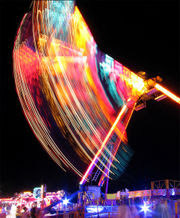 Motion blur is the apparent streaking of rapidly moving objects in a still image or a sequence of images such as a movie or animation.
Motion blur is the apparent streaking of rapidly moving objects in a still image or a sequence of images such as a movie or animation.When a camera creates an image, that image does not represent a single instant of time. Because of technological constraints or artistic requirements, the image represents the scene over a period of time. As objects in a scene move, an image of that scene must represent an integration of all positions of those objects, as well as the camera's viewpoint, over the period of exposure determined by the shutter speed. In such an image, any object moving with respect to the camera will look blurred or smeared along the direction of relative motion. This smearing may occur on an object that is moving or on a static background if the camera is moving. In a film or television image, this looks natural because the human eye behaves in much the same way.
Because the effect is caused by the relative motion between the camera, and the objects and scene, motion blur may be avoided by panning the camera to track those moving objects. In this case, even with long exposure times, the objects will appear sharper, and the background more blurred.